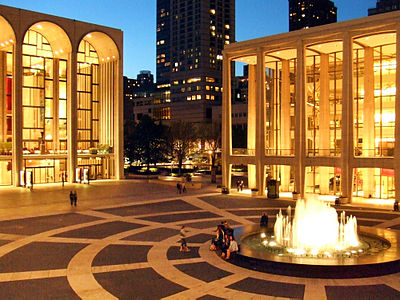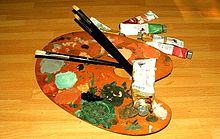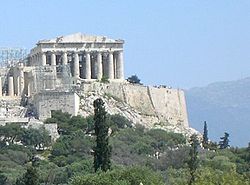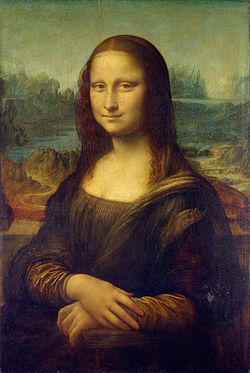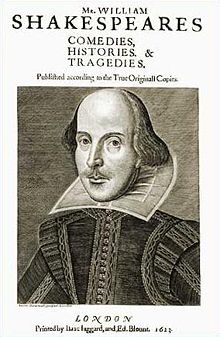- The arts
-
This article is about Arts as a group of disciplines. For the philosophical concept of art, see Art. For other uses, see Art (disambiguation).
The arts are a vast subdivision of culture, composed of many creative endeavors and disciplines. It is a broader term than "art", which as a description of a field usually means only the visual arts.[1] The arts encompass visual arts, literary arts and the performing arts – music, theatre, dance and film, among others.[2] This list is by no means comprehensive, but only meant to introduce the concept of the arts.
Contents
Definition
A good definition of the arts is given by the Free Dictionary as "imaginative, creative, and nonscientific branches of knowledge considered collectively, esp. as studied academically".[3] The singular term art is defined by the Irish Art Encyclopedia as follows: "Art is created when an artist creates a beautiful object, or produces a stimulating experience that is considered by his audience to have artistic merit."[4] So, one could conclude that art is the process that leads to a product (the artwork or piece of art), which is then examined and analyzed by experts in the field of the arts or simply enjoyed by those who appreciate the arts. The same source states:
Art is a global activity which encompasses a host of disciplines, as evidenced by the range of words and phrases which have been invented to describe its various forms. Examples of such phraseology include: Fine Arts, Liberal Arts, Visual Arts, Decorative Arts, Applied Arts, Design, Crafts, Performing Arts, and so on.
The term art commonly refers to the "Visual Arts", as an abbreviation of creative art or fine art. For example, the history of art is described as "the history of the visual arts of painting, sculpture and architecture. It is the history of one of the fine arts, others of which are the performing arts and literature. It is also one of the humanities. The term sometimes encompasses theory of the visual arts, including aesthetics." In the article for fine art, we read:
Confusion often occurs when people mistakenly refer to the Fine Arts but mean the Performing Arts (Music, Dance, Drama, etc.). However, there is some disagreement here: e.g., at York University (Toronto, Canada) Fine Arts is a faculty that includes the [visual arts], design and the "Performing Arts".[5] Furthermore, creative writing is frequently considered a fine art as well.
To illustrate the previous statements, the College of Fine Arts at Stephen F. Austin State University (Nacogdoches, TX) consists of the Schools of "Art, Music and Theatre",[6] while one of the Bachelor of Fine Arts degrees at the University of British Columbia is attached to the Creative Writing Program.[7]
More work would be required to standardize the use of the terms "art" and "fine art", but for the purpose of this article the definition of "the arts" is not problematic, because it includes all the arts. One artist has even suggested that "[it] would really simplify matters if we could all just stick with visual, auditory, performance or literary – when we speak of The Arts – and eliminate “Fine” altogether".[8]
History
For all intents and purposes, the history of the arts begins with the history of art, as dealt with elsewhere. Furthermore, the history of the Performing Arts and Literature have been described in other articles --(Please see: Outline of performing arts; History of literature; prehistoric music). Some examples of creative art through the ages can be summarized here, as excerpted from the history of art.
The arts might have origins in early human evolutionary prehistory. According to a recent suggestion, several forms of audio and visual arts (rhythmic singing and drumming on external objects, dancing, body and face painting) were developed very early in hominid evolution by the forces of natural selection in order to reach an altered state of consciousness.[9] In this state, which Jordania calls battle trance, hominids and early human were losing their individuality, and were acquiring a new collective identity, where they were not feeling fear or pain, and were religiously dedicated to the group interests, in total disregards of their individual safety and life. This state was needed to defend early hominids from predators, and also to help to obtain food by aggressive scavenging. Ritualistic actions involving heavy rhythmic music, rhythmic drill, coupled sometimes with dance and body painting had been universally used in traditional cultures before the hunting or military sessions in order to put them in a specific altered state of consciousness and raise the morale of participants.[10][11]
Ancient Greek art saw the veneration of the animal form and the development of equivalent skills to show musculature, poise, beauty and anatomically correct proportions. Ancient Roman art depicted gods as idealized humans, shown with characteristic distinguishing features (i.e. Zeus' thunderbolt).
In Byzantine and Gothic art of the Middle Ages, the dominance of the church insisted on the expression of biblical and not material truths.
Eastern art has generally worked in a style akin to Western medieval art, namely a concentration on surface patterning and local colour (meaning the plain colour of an object, such as basic red for a red robe, rather than the modulations of that colour brought about by light, shade and reflection). A characteristic of this style is that the local colour is often defined by an outline (a contemporary equivalent is the cartoon). This is evident in, for example, the art of India, Tibet and Japan.
Religious Islamic art forbids iconography, and expresses religious ideas through geometry instead.
The physical and rational certainties depicted by the 19th-century Enlightenment were shattered not only by new discoveries of relativity by Einstein [1] and of unseen psychology by Freud,[2] but also by unprecedented technological development. Paradoxically the expressions of new technologies were greatly influenced by the ancient tribal arts of Africa and Oceania, through the works of Paul Gauguin and the Post-Impressionists, Pablo Picasso and the Cubists, as well as the Futurists and others.By Arun ÏĒ
The various arts
In the Middle Ages, Artes Liberales (liberal arts) taught in medieval universities as part of the Trivium: (grammar, rhetoric, and logic) and the Quadrivium (arithmetic, geometry, music, and astronomy), and the Artes Mechanicae (mechanical arts) such as metalworking, farming, cooking, business and the making of clothes or cloth. The modern distinctions between "artistic" and non-artistic skills did not develop until the Renaissance.
In modern academia, the arts are usually grouped with or a subset of the Humanities. Some subjects in the Humanities are history, linguistics, literature, and philosophy. Newspapers typically include a section on the arts.
Traditionally, the arts are classified as seven although the list has been expanded to nine. These being Architecture, Sculpture, Painting, Music, Poetry, Dance, Theater/Cinema, with the modern non-traditional additions of Photography[12] and Comics[13].
Visual arts
Main article: Fine artFurther information: Plastic arts, Work of artDrawing
Main article: DrawingDrawing is a means of making an image, using any of a wide variety of tools and techniques. It generally involves making marks on a surface by applying pressure from a tool, or moving a tool across a surface. Common tools are graphite pencils, pen and ink, inked brushes, wax color pencils, crayons, charcoals, pastels, and markers. Digital tools which simulate the effects of these are also used. The main techniques used in drawing are: line drawing, hatching, crosshatching, random hatching, scribbling, stippling, and blending. An artist who excels in drawing is referred to as a draftswoman or draughtsman.
Gastronomy
Main article: GastronomyGastronomy is the study of the relationship between culture and food. It is often thought erroneously that the term gastronomy refers exclusively to the art of cooking (see Culinary art), but this is only a small part of this discipline; it cannot always be said that a cook is also a gourmet. Gastronomy studies various cultural components with food as its central axis. Thus it is related to the Fine Arts and Social Sciences, and even to the Natural Sciences in terms of the digestive system of the human body.
Architecture
Main article: ArchitectureArchitecture (from Latin, architectura and ultimately from Greek, αρχιτεκτων, "a master builder", from αρχι- "chief, leader" and τεκτων, "builder, carpenter")[3] is the art and science of designing buildings and structures.
A wider definition would include within its scope the design of the total built environment, from the macrolevel of town planning, urban design, and landscape architecture to the microlevel of creating furniture. Architectural design usually must address both feasibility and cost for the builder, as well as function and aesthetics for the user.
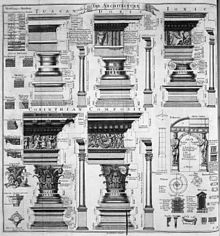 Table of architecture, Cyclopaedia, 1728
Table of architecture, Cyclopaedia, 1728
In modern usage, architecture is the art and discipline of creating an actual, or inferring an implied or apparent plan of any complex object or system. The term can be used to connote the implied architecture of abstract things such as music or mathematics, the apparent architecture of natural things, such as geological formations or the structure of biological cells, or explicitly planned architectures of human-made things such as software, computers, enterprises, and databases, in addition to buildings. In every usage, an architecture may be seen as a subjective mapping from a human perspective (that of the user in the case of abstract or physical artifacts) to the elements or components of some kind of structure or system, which preserves the relationships among the elements or components.
Planned architecture manipulates space, volume, texture, light, shadow, or abstract elements in order to achieve pleasing aesthetics. This distinguishes it from applied science or engineering, which usually concentrate more on the functional and feasibility aspects of the design of constructions or structures.
In the field of building architecture, the skills demanded of an architect range from the more complex, such as for a hospital or a stadium, to the apparently simpler, such as planning residential houses. Many architectural works may be seen also as cultural and political symbols, and/or works of art. The role of the architect, though changing, has been central to the successful (and sometimes less than successful) design and implementation of pleasingly built environments in which people live.
Painting
Main article: PaintingPainting taken literally is the practice of applying pigment suspended in a vehicle (or medium) and a binding agent (a glue) to a surface (support) such as paper, canvas, wood panel or a wall. However, when used in an artistic sense it means the use of this activity in combination with drawing, composition and other aesthetic considerations in order to manifest the expressive and conceptual intention of the practitioner. Painting is also used to express spiritual motifs and ideas; sites of this kind of painting range from artwork depicting mythological figures on pottery to The Sistine Chapel to the human body itself.
Colour is the essence of painting as sound is of music. Colour is highly subjective, but has observable psychological effects, although these can differ from one culture to the next. Black is associated with mourning in the West, but elsewhere white may be. Some painters, theoreticians, writers and scientists, including Goethe, Kandinsky, Newton, have written their own colour theory. Moreover the use of language is only a generalization for a colour equivalent. The word "red", for example, can cover a wide range of variations on the pure red of the spectrum. There is not a formalized register of different colours in the way that there is agreement on different notes in music, such as C or C#, although the Pantone system is widely used in the printing and design industry for this purpose.
Modern artists have extended the practice of painting considerably to include, for example, collage. This began with Cubism and is not painting in strict sense. Some modern painters incorporate different materials such as sand, cement, straw or wood for their texture. Examples of this are the works of Jean Dubuffet or Anselm Kiefer.
Modern and contemporary art has moved away from the historic value of craft in favour of concept; this has led some to say that painting, as a serious art form, is dead, although this has not deterred the majority of artists from continuing to practise it either as whole or part of their work.
Conceptual art
Main article: Conceptual artConceptual art is art in which the concept(s) or idea(s) involved in the work take precedence over traditional aesthetic and material concerns. The inception of the term in the 1960s referred to a strict and focused practice of idea-based art that often defied traditional visual criteria associated with the visual arts in its presentation as text. However, through its association with the Young British Artists and the Turner Prize during the 1990s, its popular usage, particularly in the UK, developed as a synonym for all contemporary art that does not practise the traditional skills of painting and sculpture.[14]
Video games
Main article: Video gameA debate exists in the fine arts and video game cultures over whether video games can be counted as an art form.[15] Some cite games such as Shadow of the Colossus and Myst as prime examples of video games as an art form. [16] Others, such as game designer Hideo Kojima, profess that video games are a type of service, not an art form. [17]
In May of 2011, the National Endowment of the Arts included video games in its redefinition of what is considered a work of art.[18]
Literary arts
Main articles: Language and LiteratureLiterature is literally "acquaintance with letters" as in the first sense given in the Oxford English Dictionary (from the Latin littera meaning "an individual written character (letter)"). The term has generally come to identify a collection of writings, which in Western culture are mainly prose, both fiction and non-fiction, drama and poetry. In much, if not all of the world, texts can be oral as well, and include such genres as epic, legend, myth, ballad, other forms of oral poetry, and as folktale.
Performing arts
Main article: Performing artsThe performing arts differ from the plastic arts insofar as the former uses the artist's own body, face, presence as a medium, and the latter uses materials such as clay, metal or paint which can be molded or transformed to create some art object.
Performing arts include acrobatics, busking, comedy, dance, magic, music, opera, operetta, film, juggling, martial arts, marching arts such as brass bands and theatre.
Artists who participate in these arts in front of an audience are called performers, including actors, comedians, dancers, musicians, and singers. Performing arts are also supported by workers in related fields, such as songwriting and stagecraft.
Performers often adapt their appearance, such as with costumes and stage makeup, etc.
There is also a specialized form of fine art in which the artists perform their work live to an audience. This is called Performance art. Dance was often referred to as a plastic art during the Modern dance era.
Music
Main article: MusicMusic is an art form whose medium is sound. Common elements of music are pitch (which governs melody and harmony), rhythm (and its associated concepts tempo, meter, and articulation), dynamics, and the sonic qualities of timbre and texture. The creation, performance, significance, and even the definition of music vary according to culture and social context. Music ranges from strictly organized compositions (and their recreation in performance), through improvisational music to aleatoric forms. Music can be divided into genres and subgenres, although the dividing lines and relationships between music genres are often subtle, sometimes open to individual interpretation, and occasionally controversial. Within "the arts", music may be classified as a performing art, a fine art, and auditory art.
Theatre
Main article: TheatreTheatre or theater (Greek "theatron", θέατρον) is the branch of the performing arts concerned with acting out stories in front of an audience using combinations of speech, gesture, music, dance, sound and spectacle — indeed any one or more elements of the other performing arts. In addition to the standard narrative dialogue style, theatre takes such forms as opera, ballet, mime, kabuki, classical Indian dance, Chinese opera and mummers' plays.
Dance
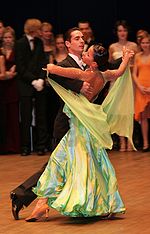 A Ballroom dance exhibition
A Ballroom dance exhibition Main article: Dance
Main article: DanceDance (from Old French dancier, perhaps from Frankish) generally refers to human movement either used as a form of expression or presented in a social, spiritual or performance setting.
Dance is also used to describe methods of non-verbal communication (see body language) between humans or animals (bee dance, mating dance), motion in inanimate objects (the leaves danced in the wind), and certain musical forms or genres.
Choreography is the art of making dances, and the person who does this is called a choreographer. People danced to relieve stress.
Definitions of what constitutes dance are dependent on social, cultural, aesthetic, artistic and moral constraints and range from functional movement (such as Folk dance) to codified, virtuoso techniques such as ballet. In sports, gymnastics, figure skating and synchronized swimming are dance disciplines while Martial arts 'kata' are often compared to dances.
Arts criticism
- Architecture criticism
- Visual art criticism
- Dance criticism
- Film criticism
- Literary criticism
- Music journalism
- Television criticism
- Theatre criticism
See also
For other uses, see The arts (disambiguation).- Art in odd places
Notes
- ^ For example here is the Art (singular) History department of Chicago which explicitly refers to "visual arts" on its welcome page.
- ^ For example here is the UNC School of the Arts (plural) which offers dance, design, drama and so on.
- ^ http://www.thefreedictionary.com/arts Entry on The Free Dictionary provided by Collins English Dictionary
- ^ http://www.visual-arts-cork.com/art-definition.htm#definition A Working Definition of Art (2009)
- ^ Faculty of Fine Arts, York University
- ^ College of Fine Arts (Stephen F. Austin State University)
- ^ The Creative Writing Program at UBC
- ^ An About.com article by artist and educator, Shelley Esaak, answering the question: What Is Visual Art? in relation to the other arts.
- ^ Joseph Jordania, 2011. Why do People Sing? Music in Human Evolution,pg 98-102
- ^ William McNeil, 1995. Keeping Together in Time: Dance and Drill in Human History. Cambridge: Harvard University Press
- ^ Jonathan Pieslak. 2009. Sound Targets: American Soldiers and Music in the Iraq War. Indiana University Press
- ^ Keppler, Victor (in English). A life of color photography: The eighth art. W. Morrow & Co. ASIN B00085HDEI.
- ^ Dierick, Charles (in Dutch). Het Belgisch Centrum van het Beeldverhaal. Brussels: Dexia Bank / La Renaissance du Livre. p. 11. ISBN 2-8046-0449-7.
- ^ Turner prize history: Conceptual art Tate gallery tate.org.uk. Accessed August 8, 2006
- ^ "From the Archives: Going Through Game Informer's Past". Game Informer (200): 83. December 2009.
- ^ Ebert, Roger. "Okay, kids, play on my lawn". Chicago Sun-Times. http://blogs.suntimes.com/ebert/2010/07/okay_kids_play_on_my_lawn.html.
- ^ "Kojima Says "Games Are Not Art"". http://kotaku.com/150043/kojima-says-games-are-not-art. Retrieved 2011-01-06. Kotaku (2006)
- ^ "US Government Declares 'Video Games Are Art'". International Business Times. 13 May 2011. http://www.ibtimes.com/articles/145535/20110513/us-government-declares-video-games-are-art.htm. Retrieved 24 August 2011.
References
- Does time fly?—Peter Galison's Empires of Time, a historical survey of Einstein and Poincare, intrigues Jon Turney. Jon Turney. The Guardian, Saturday 6 September 2003
- Contradictions of the Enlightenment: Darwin, Freud, Einstein
External links
Lists in Wikipedia Categories:- Arts
- Arts-related lists
Wikimedia Foundation. 2010.

